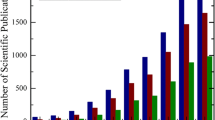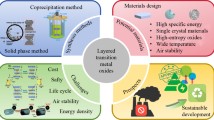Abstract
In order to meet the practical application of sodium ion batteries (SIBs), a low energy consumption method is recommended to synthesize the layered NaCrO2 cathode materials. Enabled by the larger Na+ diffusion coefficients promoted by a proper high temperature, the as-synthesized O3-type NaCrO2 material shows superior rate performance even at elevated temperatures, exhibiting 47.4 mA h g−1 at 100 C and 60°C. Opposite to the good cyclic capability at room temperature, however, the high-temperature cyclability of NaCrO2 deteriorates due to the complex irreversible structural evolution in NaCrO2 during cycling at elevated temperatures. This work boosts the industrial development of layered oxide cathode materials for SIBs with outstanding high-rate performance especially at high temperatures, and in the meantime deepens the understanding of the high-temperature capacity decay mechanism for layered oxide cathode materials.

摘要
为满足钠离子电池的实际应用, 本文采用一种低能耗方法合成了层状NaCrO2**极材料. 合成的O3型NaCrO2**极材料即使在高温下也表现出优异的倍率性能. 在60°C, 100 C倍率下测试时比容量高达47.4 mA h g−1, 这是由于适当的高温促进了Na+的扩散. 然而, 与室温下良好的循环性能相比, 高温循环过程中NaCrO2发生了复杂的不可逆结构演变, 这导致NaCrO2高温循环性能下降. 这项工作将推动具有优异倍率性能、尤其是优异高温倍率性能的钠离子电池层状氧化物**极材料的产业化发展, 同时加深对层状氧化物**极材料高温容量衰减机制的理解.
Similar content being viewed by others
References
Armand M, Tarascon JM. Building better batteries. Nature, 2008, 451: 652–657
Wang PF, You Y, Yin YX, et al. Layered oxide cathodes for sodium-ion batteries: Phase transition, air stability, and performance. Adv Energy Mater, 2018, 8: 1701912
Armand M, Axmann P, Bresser D, et al. Lithium-ion batteries—Current state of the art and anticipated developments. J Power Sources, 2020, 479: 228708
Cano ZP, Banham D, Ye S, et al. Batteries and fuel cells for emerging electric vehicle markets. Nat Energy, 2018, 3: 279–289
Wu F, Maier J, Yu Y. Guidelines and trends for next-generation rechargeable lithium and lithium-ion batteries. Chem Soc Rev, 2020, 49: 1569–1614
Hwang JY, Myung ST, Sun YK. Sodium-ion batteries: Present and future. Chem Soc Rev, 2017, 46: 3529–3614
Huang ZX, Gu ZY, Heng YL, et al. Advanced layered oxide cathodes for sodium/potassium-ion batteries: Development, challenges and prospects. Chem Eng J, 2023, 452: 139438
Zhou A, Cheng W, Wang W, et al. Hexacyanoferrate-type Prussian blue analogs: Principles and advances toward high-performance sodium and potassium ion batteries. Adv Energy Mater, 2020, 11: 2000943
Lao M, Zhang Y, Luo W, et al. Alloy-based anode materials toward advanced sodium-ion batteries. Adv Mater, 2017, 29: 1700622
**g WT, Yang CC, Jiang Q. Recent progress on metallic Sn- and Sb-based anodes for sodium-ion batteries. J Mater Chem A, 2020, 8: 2913–2933
** T, Li H, Zhu K, et al. Polyanion-type cathode materials for sodium-ion batteries. Chem Soc Rev, 2020, 49: 2342–2377
**ao J, Li X, Tang K, et al. Recent progress of emerging cathode materials for sodium ion batteries. Mater Chem Front, 2021, 5: 3735–3764
Yabuuchi N, Yoshida H, Komaba S. Crystal structures and electrode performance of alpha-NaFeO2 for rechargeable sodium batteries. Electrochemistry, 2012, 80: 716–719
Reddy Boddu VR, Palanisamy M, Sinha L, et al. Hysteresis abated P2-type NaCoO2 cathode reveals highly reversible multiple phase transitions for high-rate sodium-ion batteries. Sustain Energy Fuels, 2021, 5: 3219–3228
Wang L, Wang J, Zhang X, et al. Unravelling the origin of irreversible capacity loss in NaNiO2 for high voltage sodium ion batteries. Nano Energy, 2017, 34: 215–223
Wang S, Wang G, Che X, et al. Enhancing the capacitive deionization performance of NaMnO2 by interface engineering and redox-reaction. Environ Sci-Nano, 2019, 6: 2379–2388
Liang J, Liu L, Liu X, et al. O3-type NaCrO2 as a superior cathode material for sodium/potassium-ion batteries ensured by high structural reversibility. ACS Appl Mater Interfaces, 2021, 13: 22635–22645
Huang ZX, Zhang XL, Zhao XX, et al. Hollow Na0.62K0.05Mn0.7Ni0.2−Co0.1O2 polyhedra with exposed stable {001} facets and K riveting for sodium-ion batteries. Sci China Mater, 2023, 66: 79–87
Geng F, Yang Q, Li C, et al. Operando EPR and EPR imaging study on a NaCrO2 cathode: Electronic property and structural degradation with Cr dissolution. J Phys Chem Lett, 2021, 12: 781–786
Li W, Wang Y, Hu G, et al. Ti-doped NaCrO2 as cathode materials for sodium-ion batteries with excellent long cycle life. J Alloys Compd, 2019, 779: 147–155
Wang Y, Li W, Hu G, et al. Electrochemical performance of large-grained NaCrO2 cathode materials for Na-ion batteries synthesized by decomposition of Na2Cr2O7·2H2O. Chem Mater, 2019, 31: 5214–5223
Liang L, Sun X, Denis DK, et al. Ultralong layered NaCrO2 nanowires: A competitive wide-temperature-operating cathode for extraordinary high-rate sodium-ion batteries. ACS Appl Mater Interfaces, 2019, 11: 4037–4046
Wang S, Chen F, He X, et al. Self-template synthesis of NaCrO2 submicrospheres for stable sodium storage. ACS Appl Mater Interfaces, 2021, 13: 12203–12210
Ko W, Cho MK, Kang J, et al. Exceptionally increased reversible capacity of O3-type NaCrO2 cathode by preventing irreversible phase transition. Energy Storage Mater, 2022, 46: 289–299
Marco JF, Gancedo JR, Gracia M, et al. Characterization of the nickel cobaltite, NiCo2O4, prepared by several methods: An XRD, XANES, EXAFS, and XPS study. J Solid State Chem, 2000, 153: 74–81
Liang L, Jiang F, Cao Y, et al. One strategy to enhance electrochemical properties of Ni-based cathode materials under high cut-off voltage for Li-ion batteries. J Power Sources, 2016, 328: 422–432
Xu P, Miao C, Feng J, et al. A novel material NiOOH directly grown on in-situ etched Cu(OH)2 nanowire with high performance of electrochemical energy storage. Electrochim Acta, 2017, 232: 445–455
Yuan C, Li J, Hou L, et al. Ultrathin mesoporous NiCo2O4 nanosheets supported on Ni foam as advanced electrodes for supercapacitors. Adv Funct Mater, 2012, 22: 4592–4597
Kubota K, Ikeuchi I, Nakayama T, et al. New insight into structural evolution in layered NaCrO2 during electrochemical sodium extraction. J Phys Chem C, 2014, 119: 166–175
Liang L, Zhang W, Denis DK, et al. Comparative investigations of high-rate NaCrO2 cathodes towards wide-temperature-tolerant pouch-type Na-ion batteries from −15 to 55°C: Nanowires vs. bulk. J Mater Chem A, 2019, 7: 11915–11927
Liu K, Liu Y, Lin D, et al. Materials for lithium-ion battery safety. Sci Adv, 2018, 4: eaas9820
Yang C, **n S, Mai L, et al. Materials design for high-safety sodium-ion battery. Adv Energy Mater, 2020, 11: 2000974
Rui XH, Yesibolati N, Li SR, et al. Determination of the chemical diffusion coefficient of Li+ in intercalation-type Li3V2(PO4)3 anode material. Solid State Ion, 2011, 187: 58–63
Wang S, Chen F, Zhu T, et al. In situ-formed Cr2O3 coating on NaCrO2 with improved sodium storage performance. ACS Appl Mater Interfaces, 2020, 12: 44671–44678
Zhang W, Li H, Zhang Z, et al. Full activation of Mn4+/Mn3+ redox in Na4MnCr(PO4)3 as a high-voltage and high-rate cathode material for sodium-ion batteries. Small, 2020, 16: 2001524
Katayama N, Kawamura T, Baba Y, et al. Thermal stability of propylene carbonate and ethylene carbonate–propylene carbonate-based electrolytes for use in Li cells. J Power Sources, 2002, 109: 321–326
Wang F, Zhang N, Zhao X, et al. Realizing a high-performance Nastorage cathode by tailoring ultrasmall Na2FePO4F nanoparticles with facilitated reaction kinetics. Adv Sci, 2019, 6: 1900649
Zhang Q, Cheng X, Wang C, et al. Sulfur-assisted large-scale synthesis of graphene microspheres for superior potassium-ion batteries. Energy Environ Sci, 2021, 14: 965–974
Bo SH, Li X, Toumar AJ, et al. Layered-to-rock-salt transformation in desodiated NaxCrO2 (x < 0.4). Chem Mater, 2016, 28: 1419–1429
Yu CY, Park JS, Jung HG, et al. NaCrO2 cathode for high-rate sodium-ion batteries. Energy Environ Sci, 2015, 8: 2019–2026
Zhou YN, Ding JJ, Nam KW, et al. Phase transition behavior of NaCrO2 during sodium extraction studied by synchrotron-based X-ray diffraction and absorption spectroscopy. J Mater Chem A, 2013, 1: 11130–11134
Tsuchiya Y, Glushenkov AM, Yabuuchi N. Effect of nanosizing on reversible sodium storage in a NaCrO2 electrode. ACS Appl Nano Mater, 2017, 1: 364–370
Acknowledgements
This work was supported by the National Natural Science Foundation of China (21673051) and the Natural Science Foundation of Guangdong Province of China (2021A1515010388). The authors would like to acknowledge the partial experimental facilities provided by Songshan Lake Materials Laboratory.
Author information
Authors and Affiliations
Contributions
Meng X and Liang J synthesized the samples and conducted the tests; Liang M, Li W, and Lin C participated in the analysis and discussion of the data; Ke X offered helpful suggestion; Meng X wrote the article with the support of Liu L and Shi Z.
Corresponding author
Ethics declarations
The authors declare that they have no conflict of interest.
Additional information
Supplementary information
Supporting data are available in the online version of the paper.
**angcong Meng received his Bachelor’s degree from Zhengzhou University. He is currently a Master student at Guangdong University of Technology. His research interests mainly focus on high-performance cathode materials for lithium/sodium-ion batteries.
Liying Liu received her Bachelor degree from the Central South University of Technology in 1998 and then obtained the PhD degree from the Northeastern University in 2006. She is now an associate professor at Guangdong University of Technology. She ever worked as a visiting fellow at the University of Wollongong in Australia for two years. Her research focuses on electrode materials for alkali metal ion batteries.
Zhicong Shi received his PhD degree in physical chemistry from **amen University in 2005. He joined Dalian University of Technology as an associate professor after a postdoctoral fellowship at the University of Alberta, Canada. Now he is a professor at the School of Materials and Energy, Guangdong University of Technology. His current research interests focus on the design, characterization, and understanding of the working mechanism of materials for supercapacitors, batteries and fuel cells.
Supporting Information
40843_2023_2493_MOESM1_ESM.pdf
Superior rate performance and structural evolution of O3-type layered NaCrO2 for sodium ion batteries at high temperatures
Rights and permissions
About this article
Cite this article
Meng, X., Liang, J., Liang, M. et al. Superior rate performance and structural evolution of O3-type layered NaCrO2 for sodium ion batteries at high temperatures. Sci. China Mater. 66, 3445–3452 (2023). https://doi.org/10.1007/s40843-023-2493-9
Received:
Accepted:
Published:
Issue Date:
DOI: https://doi.org/10.1007/s40843-023-2493-9




